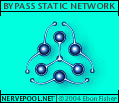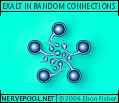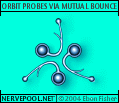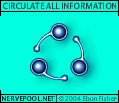Ebon Fisher Explores Subversive
Play
Mike Tanner, Wired News, May, 1997
"I consider myself a mind artist," says Ebon Fisher,
one of the original teachers at the MIT Media Lab and a cultivator of the
now pervasive "meme" meme. "I take a concept and grow it interactively."
Fisher is referring to his biomorphic diagrams,
which represent "human-machine interactions" as interlocking groups of
nerve-shaped forms, accompanied by slogans about linking with others (such
as "link via infant node"). These works, titled The Bionic Codes, have
existed in media as varied as stickers, T-shirts, zines, nightclub projections,
and now inhabit a Java-driven interactive game on the Sandbox webzine which
launched on Tuesday.
This migration between media is emblematic both
of the mutability inherent in Fisher's art, and of the kind of work that
Sandbox has been covering as a paper zine and performance collective for
the last three years. The group has worked - mostly with artists associated
with the Williamsburg performance/installation party scene of the early
'90s - to examine the medium-specific nature of art and "explore the manifold
aspects of subversive and creative play."
"Play," says Sandbox editor Sylvie Myerson, implies
not only the child-like pursuit of fun but also the urge to "play with
something to see how it works." The work isn't overtly political, she adds,
but "the idea of adults creating something that's not for anything commercial
is in itself subversive."
The new site features conceptual, interactive
audio, and visual pieces by Sandbox artists, as well as reviews and archives
of articles from the paper zine. Some work, like Fisher's diagrams are
obviously adaptable to the Web, while some - like Sally Resnik's participatory
ceramics-and-paper "rituals" - are not. By hosting events for each issue
of the paper magazine, however, Sandbox has given its contributors "the
opportunity to work directly with the audience," and this interaction is
something Myerson hopes will transfer to the Web. For Resnik's piece, she
says, they've "managed to adapt it and create the experience of an online
ritual for people." Images of Resnik's sculptures and performances are
added to sound files from the events, and viewers are able to send in answers
to questions that will become part of the piece.
Though run as part of a nonprofit organization
by a staff with other day-jobs - including freelance editorial worker Myerson
and copublisher and design chief Vid Jain - the Sandbox site is scheduled
for monthly updates of the reviews and other text pieces, while the heavy-production
features will be revamped twice a year.

RETURN



